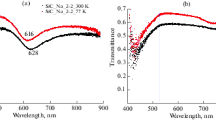Conclusions
Impurities in silicon carbide have a considerable effect on the life of heating elements and their physicomechanical properties. It is necessary to use silicon carbide of at least 98% purity for the manufacture of high-grade heating elements. Impurities should be not more than 2%, and the content of ferric oxide and alumina should not exeed 0.5%.
Similar content being viewed by others
Literature cited
K. A. Karayanopulo and A. N. Novikov, Trans. All-Union Inst. Refractories (VIO), 1939, No. 18.
R. I. Bresker and N. I. Voronin, Trans. All-Union Inst. Refractories (VIO), 1960, No. 30.
Author information
Authors and Affiliations
Rights and permissions
About this article
Cite this article
Bresker, R.I., Voronin, N.I. & Khrycheva, D.D. Influence of impurities in silicon carbide on the properties of heating elements. Refractories 4, 93–97 (1963). https://doi.org/10.1007/BF01283240
Issue Date:
DOI: https://doi.org/10.1007/BF01283240




